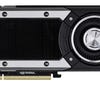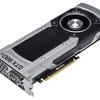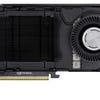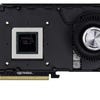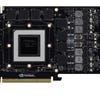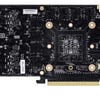Nvidia GeForce GTX 980 Ti review
Cheaper than Titan X, with virtually identical performance.
We knew it was coming, of course - it was just the speed of its arrival that took us off-guard. Nvidia's astonishing Titan X graphics card, based on the 8bn transistor GM200 processor, redefined the boundaries of single-GPU performance when we reviewed it back in March. Imagine the firm's previous flagship - the GTX 980 - combined with a mainstream GTX 960 in a single package, backed by a ridiculous 12GB of 7gbps GDDR5 and you have a remarkable technological achievement. The only problem was its price - $999. The new GTX 980 Ti is a mildly cut-back version of the same product, offering around 98 per cent of the raw performance at 65 per cent of the price.
That's not a bad outcome bearing in mind the extent of the compromises Nvidia has made. The 3072 cores of the Titan X get cut-down by a factor of nine per cent, two shader clusters disabled to give us a final tally of 2816 stream processors. By extension, we lose some texture mapping units too - dropping from 196 in Titan X to 176 in the GTX 980 Ti. However, the biggest cutback is perhaps the most inconsequential of all, bearing in mind the current gaming landscape. The mammoth 12GB of GDDR5 found in the top-end flagship is pared back to a still lavish, but more reasonable 6GB. However, memory speeds remain the same, core and boost clocks are identical, and unlike the GTX 970, Nvidia's cutbacks have not come at the expense of ROPs or bandwidth - both are identical to Titan X. To be clear, this time there are no split-memory shenanigans.
Graphics cards are parallel by nature, distributing work across however many cores are available. That being the case, it's a totally reasonable assumption to suggest that losing around nine per cent of the computational power should result in a similar drop to overall performance. However, raw processing power is just one element of the equation and in a card which is seemingly already hitting bottlenecks elsewhere within the system (be it the driver, the DX11 API or the CPU), the reality is that the GTX 980 Ti is virtually interchangeable with its much more expensive sibling.
Indeed, at a couple of points during our testing, the 980 Ti actually seemed a tiny bit faster than Titan X - theoretically impossible of course, but a practical reality when two cards with so much computational power butt up against limitations elsewhere within the system. That's no mean feat considering our test system uses a Core i7 4790K overclocked to 4.6GHz along with 16GB of 1600MHz DDR3 RAM. On top of that, in common with the entire Maxwell line of Nvidia GPUs, the GTX 980 Ti is a very decent overclocker - not only can you increase speeds to match Titan X, you can move considerably beyond its stock performance too.
- Order the GeForce GTX 980 Ti 6GB from Amazon with free shipping
Similarities with the top-end card don't end at the specs either. Aside from a colour scheme more in keeping with the rest of the GeForce line, the GTX 980 Ti boasts the same high-quality chassis and excellent cooler found on Titan X. TDP is the same at 250W, meaning that the six and eight-pin power input arrangement remains in place, while identical video outputs remain in place - one dual-link DVI, three DisplayPorts, plus an HDMI 2.0 port, allowing for a 4K pixel throughput at 60Hz.
All of which is fascinating of course, but what you're really here for is the performance - validation that you can enjoy Titan X levels of rendering power without paying quite so much for the privilege. We kick off with our standard gameplay test, upgraded for this new top-tier of graphics hardware. We're running Crysis 3 at its highest visual quality, with top-tier textures engaged and SMAA T2x anti-aliasing in play. Up until the arrival of Titan X, we've carried out this test at 1080p resolution, but it's clear that this is not going to stress this new wave of Nvidia hardware at all, so we move on to 2560x1440.
A standard benchmark involves turning v-sync off and running the game at the absolute fastest refresh it can manage (and if that's your bag, we've got more than enough testing of that ilk further on down the page). However, in our opinion, the optimal gameplay experience is to match the native resolution of your display and its refresh rate. In short, we want something as close to locked, consistent 60fps as possible, while maintaining 1440p resolution on this highly demanding game.
The results? Well, there's just a 0.79 per cent variance from the target frame-rate between the new card and the more capable Titan X - margin of error stuff, really. The GTX 980 Ti fails to hit the target for just 3.35 per cent of the duration, up against the somewhat more noticeable 20.66 per cent of the older GTX 980 - but Titan X remains top of the pile with a mere 2.56 per cent of dropped frames. Bearing in mind that the playthroughs seen here are not totally like-for-like, it's clear that we're going to need a more forensic look at game engines in motion to separate the two GM200 cards.
| Crysis 3 1440p60/V-Sync Gameplay | GTX 980 Ti | GTX Titan X | GTX 980 |
|---|---|---|---|
| Lowest Frame-Rate | 44.0fps | 44.0fps | 31.0fps |
| Dropped Frames (from 18650 total) | 624 (3.35%) | 477 (2.56%) | 3852 (20.66%) |
Order the graphics cards tested against the GTX 980 Ti from Amazon with free shipping:
GTX 980 Ti wasn't really designed to run games at 1080p resolution, and as we noted in our Titan X review, this is where the like-for-like gains over the GTX 980 are at their lowest. Across all nine games we tested, there's an average boost of just 24.8 per cent in performance compared to the reference GTX 980 - a figure likely to fall significantly if you bought (or are in the market for) a third-party board such as the excellent GTX 980 Strix from Asus or the equally impressive MSI Gaming 4G model.
Our biggest gains come from well-optimised games with a fair amount of CPU overhead left over: Ryse and Shadow of Mordor are 29 per cent faster, and Tomb Raider and Crysis 3 aren't too far behind. Worst performer of the bunch is Far Cry 4 with a mere 15.8 per cent boost - which may have something to do with its over-reliance on single thread CPU performance.
However, for many, it's the comparison with Titan X that is of most relevance. At stock settings, an average of all titles sees the GTX 980 Ti hand in 98.6 per cent of the Titan X's performance and not one title fell below the 97 per cent threshold. We'll go into overclocking in a touch more depth later, but as you can see, the GTX 980 Ti easily boosts past the thousand dollar flagship's stock performance (of course, you can overclock that too). That said, you don't get the best value from your OC at 1080p - there's an average increase of 11.2 per cent, the biggest improvements coming from Battlefield 4 and Shadow of Mordor at 14 per cent. Bearing in mind we implemented a 220MHz core clock boost, along with an additional 400MHz on the RAM, that's not exactly a great return.
| 1920x1080 (1080p) | R9 290 | R9 290X | GTX 970 | GTX 980 | GTX 980 Ti | GTX 980 Ti OC | Titan X |
|---|---|---|---|---|---|---|---|
| The Witcher 3, Ultra, HairWorks Off, Custom AA | 46.4 | 50.5 | 56.0 | 65.8 | 82.6 | 92.1 | 84.4 |
| Battlefield 4, Ultra, 4x MSAA | 64.3 | 68.0 | 74.6 | 86.5 | 109.9 | 125.4 | 112.4 |
| Crysis 3, Very High, SMAA | 65.4 | 70.2 | 71.4 | 81.5 | 104.0 | 115.5 | 105.2 |
| Assassin's Creed Unity, Ultra High, FXAA | 38.0 | 42.6 | 51.7 | 62.4 | 74.4 | 84.3 | 74.7 |
| Far Cry 4, Ultra, SMAA | 72.2 | 75.0 | 77.4 | 87.4 | 101.2 | 103.0 | 101.4 |
| COD Advanced Warfare, Extra, FSMAA | 90.5 | 92.9 | 117.8 | 128.0 | 156.8 | 173.1 | 159.9 |
| Ryse: Son of Rome, High, SMAA | 69.2 | 74.8 | 65.1 | 75.8 | 97.8 | 109.5 | 99.2 |
| Shadow of Mordor, Ultra, High Textures, FXAA | 82.8 | 88.3 | 80.8 | 91.7 | 118.5 | 135.4 | 119.0 |
| Tomb Raider, Ultimate, FXAA | 84.1 | 89.0 | 102.4 | 118.2 | 150.1 | 168.2 | 150.3 |
At 2560x1440, the gap with GTX 980 opens up still further as the advantages of the 384-bit memory bus come further into play. Increases to performance compared to GTX 980 still vary though, with some fairly disappointing results from Assassin's Creed Unity, Advanced Warfare and Far Cry 4 - all in the 22-23 per cent area. However, BF4, Crysis 3 and Ryse all comfortably break the 30 per cent threshold, with The Witcher 3 and Tomb Raider getting extremely close.
1440p resolution also sees our overclock hits its optimal level of performance, averaging out across all nine games with an impressive 15.6 increase to frame-rates (ACU faring worst at 12.6 per cent, with Tomb Raider achieving an impressive 18.4 per cent boost). Bearing in mind that the GTX 980's effectiveness declines as you raise resolution, the 980 Ti's showing here isn't unexpected, but it is welcome nonetheless.
The fact that the new card features the exact same level of memory bandwidth as Titan X may also explain the stand-out result here, as Shadow of Mordor sees its performance matched exactly between the two GM200 cards. Across all games, the GTX 980 Ti handed in 98 per cent of the Titan X's performance - very, very slightly down compared to the 1080p results, but once again not a single game managed less than 97 per cent of the more expensive card's performance.
| 2560x1440 (1440p) | R9 290 | R9 290X | GTX 970 | GTX 980 | GTX 980 Ti | GTX 980 Ti OC | Titan X |
|---|---|---|---|---|---|---|---|
| The Witcher 3, Ultra, HairWorks Off, Custom AA | 35.3 | 38.2 | 39.2 | 47.5 | 61.7 | 70.9 | 63.3 |
| Battlefield 4, Ultra, 4x MSAA | 43.4 | 46.8 | 48.9 | 57.0 | 75.0 | 86.7 | 76.1 |
| Crysis 3, Very High, SMAA | 42.0 | 45.1 | 43.0 | 50.0 | 66.2 | 75.7 | 68.0 |
| Assassin's Creed Unity, Ultra High, FXAA | 26.6 | 29.5 | 32.8 | 39.4 | 48.3 | 54.4 | 49.6 |
| Far Cry 4, Ultra, SMAA | 53.2 | 57.8 | 53.9 | 61.3 | 75.4 | 86.9 | 77.0 |
| COD Advanced Warfare, Extra, FSMAA | 77.2 | 81.5 | 87.0 | 98.2 | 121.3 | 139.4 | 123.2 |
| Ryse: Son of Rome, High, SMAA | 51.8 | 55.6 | 46.3 | 54.1 | 71.2 | 83.3 | 72.8 |
| Shadow of Mordor, Ultra, High Textures, FXAA | 61.3 | 65.7 | 57.0 | 66.0 | 87.2 | 101.8 | 87.2 |
| Tomb Raider, Ultimate, FXAA | 56.9 | 62.4 | 65.5 | 76.7 | 99.2 | 117.2 | 101.9 |
Moving on to 4K resolution, here's where the GM200 cards comfortably pull ahead of the GTX 980 - the 384-bit memory really coming its own, and in many ways, taking centre-stage. Disappointments in terms of performance increases are fewer, Assassin's Creed Unity's mere 22 per cent the outlier in an area where boosts in excess of 30 per cent are much more common. The average performance increase up across all games up against GTX 980 just about hits 30 per cent, but more important than the raw numbers is the gameplay experience: with some settings tweakage, all of our test titles bar ACU are eminently playable at this extreme resolution, some of them even approaching 60fps.
The importance of memory bandwidth is reflected in the fact that GTX 980 Ti seems to be even closer to Titan X performance-wise than at 1440p, to the point where occasionally we see the less capable card very slightly outperforming the full GM200 in our tests - margin of error stuff on titles where CPU bottlenecks can cause an issue, and indicative of just how close these two GPUs are in actual real-life conditions. Also noteworthy is that our overclock offers diminishing returns at 4K - just a 10 per cent boost to frame-rates on average.
Regardless, it's at the high end that GTX 980 Ti hits its stride. Combine the new card with one of the upcoming 4K G-Sync monitors and we could be onto a winning combination, but the recent announcement of a 34-inch, curved 21:9 screen from Acer - the G-Sync enabled XR341CKA - could well see the GM200 GPUs find their true calling. It features a 3440x1440 resolution - 60 per cent of 4K resolution - but with a wider fielder of view and less extreme pixel density, making it great for productivity as well as gaming (and side-stepping Windows' lacklustre DPI scaling). Other '3.4K' panels are available of course, but as far as we know, only the Acer packs in G-Sync too.
| 3840x2160 (4K) | R9 290 | R9 290X | GTX 970 | GTX 980 | GTX 980 Ti | GTX 980 Ti OC | Titan X |
|---|---|---|---|---|---|---|---|
| The Witcher 3, High, HairWorks Off, Custom AA | 23.6 | 26.0 | 22.8 | 27.7 | 36.9 | 40.7 | 37.5 |
| Battlefield 4, High, Post-AA | 36.9 | 39.4 | 39.5 | 46.8 | 61.0 | 69.6 | 61.3 |
| Crysis 3, High, SMAA | 33.9 | 36.0 | 31.9 | 39.0 | 52.5 | 59.7 | 52.4 |
| Assassin's Creed Unity, Very High, FXAA | 16.6 | 18.1 | 18.4 | 21.8 | 26.5 | 29.0 | 27.4 |
| Far Cry 4, Very High, SMAA | 33.3 | 36.0 | 30.0 | 36.1 | 47.1 | 50.9 | 46.7 |
| COD Advanced Warfare, Console Settings, FXAA | 60.2 | 62.1 | 59.6 | 69.0 | 86.9 | 96.9 | 90.8 |
| Ryse: Son of Rome, Normal, SMAA | 31.2 | 34.0 | 25.7 | 31.5 | 41.7 | 45.6 | 42.2 |
| Shadow of Mordor, High, High Textures, FXAA | 41.5 | 44.8 | 35.3 | 42.3 | 54.8 | 59.7 | 54.8 |
| Tomb Raider, Ultra, FXAA | 37.6 | 41.0 | 39.0 | 47.0 | 61.3 | 66.0 | 64.6 |
With the performance testing done and dusted, let's discuss heat, acoustics and overclocking. As expected, GTX 980 Ti is very similar indeed to Titan X, right down to the intermittent (but not obtrusive) 'coil whine' and its tendency to level out at temperatures of around 80 degrees Celsius under load. At stock speeds, the card is very quiet with the reference cooler, only becoming noticeable once you start to dabble with overclocking.
In this area, we found that the 980 Ti is able to hit and sustain core speeds in the 1400MHz area with boost active. We managed this by pushing max power draw up to its maximum 110 per cent, adding 220MHz to the core clock, and 400MHz to the RAM (taking us up to 7.8gbps in total). During our Titan X testing, we didn't have access to over-volting, but MSI Afterburner has that functionality now and it works with GTX 980 Ti too. Unfortunately, 1400MHz or thereabouts does seem to be the core's limit - we couldn't push further without obvious instability. Remember, GM200 is a relatively massive chip, and typically, the larger the processor the less overclocking headroom is available. Additionally, our memory overclock was slightly less effective than our tests with Titan X, where we could hit 465MHz.
Power consumption remains impressive, and again, pretty much identical to the more expensive GM200 card in Nvidia's line-up: we hit a peak of 362W drawn from the wall during the Metro Last Light benchmarking sequence running at 1440p on max settings. That's almost identical to the much less capable Radeon R9 290X, once again highlighting Maxwell's excellent power efficiency, even on the top of the line, no holds barred products.
| R9 290 | R9 290X | GTX 970 | GTX 980 | GTX 980 Ti | GTX 980 Ti OC | Titan X | |
|---|---|---|---|---|---|---|---|
| Peak System Power Draw | 340W | 363W | 265W | 265W | 362W | 396W | 364W |
Nvidia GeForce GTX 980 Ti - the Digital Foundry verdict
The arrival of the GTX 980 Ti causes a mild ripple effect to prices elsewhere in Nvidia's high-end GPU line-up. The GTX 980 - still a remarkably good card, by the way - drops down to $499, but the value-rific GTX 970 remains at its previous $330. In a world where price doesn't tend to scale in a linear fashion with performance at the premium end of the market, at least with the 980 Ti you are getting an approximate 30 per cent boost in frame-rates for an equivalent amount of cash compared to the older 980. However, the fact remains that GTX 980 and the new 980 Ti are still priced somewhat at the extreme side. How long they will stay there all depends on just how fast AMD's upcoming new Radeon actually is, and how much the firm intends to charge for it.
In the meantime, the new GTX 980 Ti will remain out of reach for many gamers - perhaps frustratingly so. But it's worth bearing in mind that today's halo product is tomorrow's more mainstream product. There was a time when the original Titan and its derivatives were just as expensive as Nvidia's current brace of ultra high-end cards. Fast forward to the arrival of the second-gen Maxwell architecture (and in particular the seismic debut of the GTX 970) and prices across the stack nose-dived. Doubtless, we'll see the same thing happen here in the fullness of time.
In the meantime, while the development of truly generational leaps in CPU processing power seem few and far between, it's great to see that the push for ever more powerful graphics hardware remains in full effect. Question marks remain over whether these new GPUs are being fully utilised (we really need DX12), and we still can't help but think that GM200 should be capable of more, but that can't take away from the many plus points of the product.
So, should you buy a GTX 980 Ti? As Ferris Bueller might say, "if you have the means, I highly recommend picking one up", but do bear in mind the more limited returns at lower resolutions, and perhaps hold fire until we see the performance level - and asking price - of AMD's upcoming alternative.


